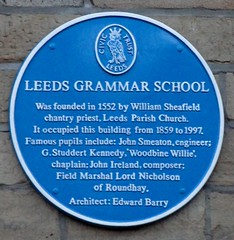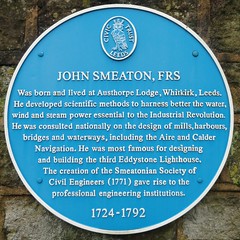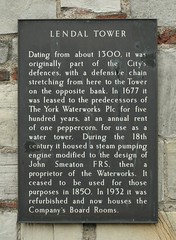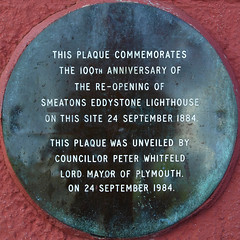John Smeaton FRS
Commemorated on 9 plaques
Leeds Grammar School Was founded in 1552 by William Sheafield, chantry priest, Leeds Parish Church. It occupied this building from 1859 to 1997. Famous pupils include: John Smeaton, engineer; G. Studdert Kennedy, 'Woodbine Willie' chaplain; John Ireland, composer; Field Marshal Lord Nicholson of Roundhay. Architect: Edward Barry
Moorland Road, Leeds, United Kingdom where they attended school
John Smeaton, FRS Was born and lived at Austhorpe Ledge, Whitkirk, Leeds. He developed scientific methods to harness better the water, wind and steam power essential to the Industrial Revolution. He consulted nationally on the design of mills, harbours, bridges and waterways, including the Aire and Calder Navigation. He was most famous for designing and building the third Eddystone Lighthouse. The creation of the Smeatonian Society of Civil Engineers (1771) gave rise to the professional engineering institutions. 1724-1792
Leeds Lock, Leeds, United Kingdom where they was born near (1724) and lived near
Revd John Michell BD. FRS 1724-1793 geologist and astronomer. Rector of Thornhill 1767 - 1793. He experimented on magnetism and astronomy, also making a Torsion balance to weigh the world. His visitors here included Henry Cavendish, William Herschel, Joseph Priestley and John Smeaton.
Thornhill Parish Church, Church Ln, Thornhill, Dewsbury, United Kingdom where they visited
This Observatory was built by the Yorkshire Philosophical Society following the inaugural meeting of the British Association for the Advancement of Science in 1831. It has an earlier rotating roof designed by John Smeaton who also designed the Eddystone Lighthouse. The Observatory housed what was for many years the largest refracting telescope in the world, designed and built by Thomas Cook of York, whose firm also built the Greenwich transit instrument. It was restored and refitted to mark the British Associations 150th Anniversary meeting in York in 1981 and was officially opened by its President H.R.H. the Duke of Kent, G.C.M.G., G.C.V.O.
Museum Gardens, York, United Kingdom where they designed
Lendal Tower. Dating from about 1300, it was originally part of the City's defences, with a defensive chain stretching from here to the Tower on the opposite bank. In 1677 it was leased to the predecessors of The York Waterworks Plc for five hundred years, at an annual rent of one peppercorn, for use as a water tower. During the 18th century it housed a steam pumping engine modified to the design of John Smeaton FRS, then a proprietor of the Waterworks. It ceased to be used for those purposes in 1850. In 1932 it was refurbished and now houses the Company's Board Rooms.
Lendal Bridge, York, United Kingdom where they designed
Eddystone Light. This bronze commemorates the centenary of the rekindling of the Eddystone Light on 18-5-1882 on completion of the tower built by James Douglass. It also marks the commissioning on 28-7-1982 of an unmanned light in that tower standing 14 miles seaward of this place on the notorius Eddystone Reef. In salutem omnium.
Smeaton's Tower, Plymouth Hoe Promenade, Plymouth, United Kingdom where they was
This plaque commemorates the 100th anniversary of the re-opening of Smeatons Eddystone Lighthouse on this site 24 September 1884.
Smeaton's Tower, Plymouth Hoe Promenade, Plymouth, United Kingdom where they was
This tablet is erected to the memory of John Smeaton FRS The distinguished civil engineer who was born in 1724 and died in 1792 at Austhorpe Lodge, Leeds, in the County of York. He designed this lighthouse and erected it on Eddystone Rock 1756 to 1759 Presented by the Lord Mayor of Leeds Alderman Percival T Leigh J.P. 1936
Smeaton's Tower, Plymouth Hoe Promenade, Plymouth, United Kingdom where they was
Smeaton's Arches Built 1770s: widened 1920s A causeway to carry the Great North Road across the floodplain of the River Trent. The work of John Smeaton, the 'father of civil engineering'
Riverside Park, Great North Road, Newark-on-Trent, United Kingdom where they built










